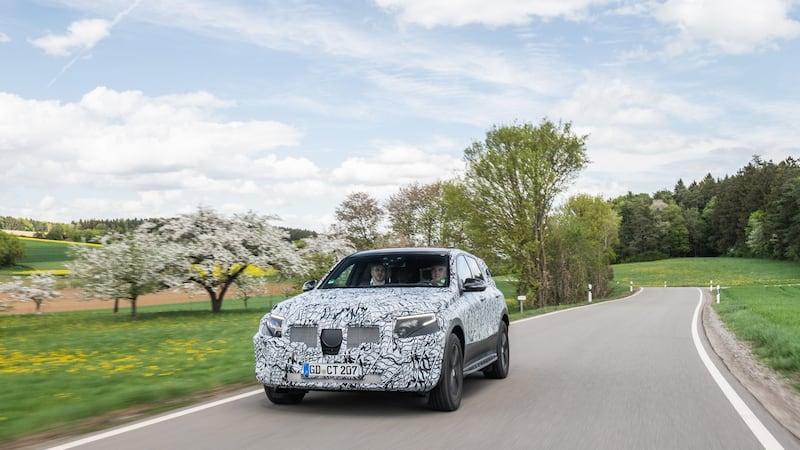The manufacturer that invented the automobile will reinvent it for 2019, when Mercedes-Benz’s EQ C finally hits the streets. That’s the pledge at least.
"It has to be a Mercedes," says Michael Keltz, chief engineer of EQ C. It is this principle which has kept Mercedes-Benz's engineers so busy.
The company’s first series production plug-in battery electric vehicle will quietly glide around Irish roads from 2019. There have been others before, toe-dipping exercises into the prospective world of electric-propelled passenger cars. They have been just that, tiny number experiments, for a handful of early adopting private and business customers.

Mercedes promises the EQ C will be different, not least as it's significant enough to come with its own "brand", that EQ name set to spearhead Mercedes-Benz's push to an alternatively-powered future. There'll be plug-in hybrids and mild hybrids, too, EQ Power being attached to those, with EQ heading up a range of electrically-powered vehicles. Dr Dieter Zetsche, chief executive of Daimler and head of Mercedes-Benz Cars, introduced the EQ brand and its ambitious plans at the 2016 Paris Auto Show. There will be 10 fully-electric models by 2022, with Mercedes-Benz aiming to offer a battery electric choice in each of its product segments.
Prototype
That charge to an electrically-powered generation will be introduced with the EQ C, the production model of the Generation EQ concept Zetsche pulled the covers off in France two years ago. We're in a prototype here, one of the many built for testing. This is and an "off-tool" example, meaning it, a few material differences aside, is virtually a production vehicle.
Dimensionally the EQ C is obviously SUV proportioned. Visually it will be very close to that 2016 Paris concept in its execution. Following the automotive zeitgeist for SUVs is sensible on two counts as it’s what buyers want, and their packaging suits an electric powertrain, even if its four-wheel drive system is tuned entirely for road driving, the EQ C having the same ride height as an E-Class saloon model.
We’re in it as it undergoes further development, taking in some of the company’s favoured testing roads around the Black Forest The goal today is to work on the ride and handling. As Keltz says: “Ride, we’re looking for Mercedes-Benz typical comfort; handling should be nice and sporty; getting it together is what we’re doing.” He’s enjoying it too, the instant torque response from the EQ C’s pair of electric motors giving this plug-in future model sharp acceleration.
Power outputs
Allowing that is the two 150kW motors, one per axle. While the power outputs are the same, how they produce their power differs. “They have different electric windings,” says Keltz, adding: “The front motor is for maximum efficiency and the rear one for maximum power – the set up is a little different to how they gain torque. We want to get fast reaction, we want high torque and power in the rear for dynamics, and if you go just straight all the time we cut off the rear and run just the front one, which is running on maximum efficiency.”
The battery, which comes from parent company Daimler's wholly-owned subsidiary Duetsche Accumotive, is, admits Keltz "around 70kWh in capacity", and accounting for about 25 per cent of the EQ C's weight. How much that overall weight is he won't reveal, but doesn't deny that it's meant the engineers in the dynamics department have had to work hard to manage it.
Where there are challenges though, there have also been opportunities, the EQ C’s technology enabling new functionality. The ESP system can work directly on the electric motors, using what Keltz describes as micro-torque management to aid the safety system, being quicker reacting and less intrusive.
No surprise
Safety is key in any Mercedes-Benz model, and so too, says Keltz, is refinement. That it’s quiet is no surprise, refinement is a high priority in any production car to wear the three-pointed star, but with an electric car the sounds from it are different, creating new challenges for the engineers.
With conventionally powered cars engineers have long been given something of a pass, with familiar, desirable sounds able to mask other less desirable noise generated elsewhere. That’s trickier in an electric vehicle, as there’s so little sound in the first place. The motors are near silent in comparison to internal combustion engines, but Keltz says even there “we took a lot of care to get rid of the electric drive noise, which sounds a bit like a train, so we wanted to get rid of these.” It’s worked, too: the EQ C we are in is eerily quiet as it drives, even at autobahn speeds of up to 190km/h (118mph) the only noise being that of the wind rushing by, and even that’s pretty muted.
Biggest question
Electric vehicles are quiet then, but the biggest question always centres around range and charging times. At the concept’s unveiling Mercedes-Benz originally quoted a figure of about 500km for the EQ C’s potential range, but under the new WLTP testing it’ll be less. Even if it’s closer to 350km Mercedes-Benz insiders point to the growing rapid charging structure and Mercedes-Benz’s CASE strategy as facilitating the shift to electric vehicles. With a 115kW charger a top-up to half full a charge should take about 20 minutes, though Keltz does say it depends on how many vehicles are charging, and at what state of charge the battery is at.
Charging is something that we’ll increasingly get used to, the electric car conundrum is always one that’s mixed up with infrastructure provision. With the cars now coming on stream fast, that will require some serious work. With the cars coming on stream quickly, and the EQ C joined by a host of other premium models as well as mainstream ones in the next few years, there’s a clear shift in how we’ll be driving in the future.










